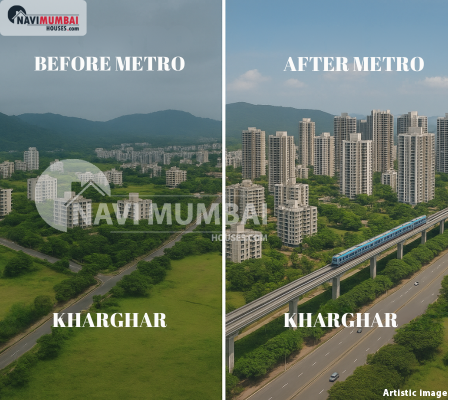
The Promise of Faster, Smarter Commuting
Imagine stepping out of your home, walking a few minutes, boarding a metro, and reaching CBD Belapur, Vashi, or Taloja in 10–15 minutes—without traffic, fuel costs, or stress. That’s not a distant dream. The metro lines coming up across Navi Mumbai are turning this into a daily reality.
For real estate projects, this mobility shift is more than a convenience—it’s a structural lever that can change demand, pricing, and investor confidence.
Problem / Current Pain: Roads, Traffic & Connectivity Gaps
-
Many residential nodes in Navi Mumbai still depend heavily on roads or local buses. Congestion, delays, and last-mile challenges are common complaints.
-
Buyers increasingly avoid areas that are “far from transport” even if rates are lower, because daily commuting becomes a burden.
-
Developers launching projects far from connectivity often struggle to sell or maintain steady demand.
These are real deterrents for someone looking for a home or investment in Navi Mumbai.
Solution / How Metro Changes the Game
Metro connectivity addresses many of the above problems. Here’s how it boosts real estate projects:
1. Demand Shifts Toward Metro-Linked Projects
Properties closer to metro stations attract more buyer interest. Already, in Kharghar, the operational Metro Line 1 (Belapur to Pendhar) has increased footfall and property demand.
Buyers favor “walk-to-metro” homes—less commuting stress means higher willingness to pay.
2. Faster Capital Appreciation
Metro-adjacent properties tend to appreciate faster. Studies (and local trends) often show a 10–15% premium for homes near metro corridors.
As metro expansions roll out, earlier-phase projects near metro corridors gain more value compared to remote projects.
3. Stronger Rental & Occupancy Potential
Tenants, especially professionals and students, prefer homes with good public transport access. Metro connectivity increases demand for rentals, reducing vacancy risk for developers.
In Navi Mumbai, lines like the Belapur–Taloja corridor already show signs of boosting peripheral nodes.
4. Enables New Nodes & Satellite Townships
Areas far from traditional hubs become viable places to live and invest once metro lines reach them. Developers can launch new townships without the “too remote” label.
Nodes like Ulwe, Panvel, and Taloja benefit more when the metro is extended to them, coupled with airport, road, and transit infrastructure.
5. Confidence in Infrastructure Planning
When metro projects are sanctioned, budgeted, and visibly progressing, it boosts buyer trust. Developers in Navi Mumbai use metro adjacency as a key selling point.
Godrej Properties, for example, links its projects’ value story to metro connectivity.
Proof / Examples & Trends
-
The Kharghar Metro (Line 1, Belapur to Pendhar) has been operational since November 2023. Already, real estate projects near its stations are seeing stronger demand.
-
Along the Navi Mumbai Metro routes, nodes like Belapur, Taloja, and Kharghar show rising demand and upward pressure on rates.
-
Infrastructure developments beyond metro—like the Mumbai Trans Harbour Link and upcoming NMIA—are creating synergistic growth. Nodes served by metro + these links see compounding advantages.
Desire & Action: What Developers, Buyers Should Do
If you are a developer, investor, or homebuyer, here’s how to use metro connectivity to your advantage:
For Developers / Project Planners:
-
Acquire or develop land close to upcoming metro corridors or stations.
-
Promote “last-mile connectivity” (shuttle services, pedestrian paths) from the station to the project.
-
Phase development so that earlier phases (closer to the station) can command premium pricing.
-
Integrate mixed-use, retail, and amenities near stations to add value.
For Buyers / Investors:
-
Look for projects with declared proximity to metro stations; check if the station is fully sanctioned, funded, or in execution.
-
Compare premium vs payout: how much extra are you paying for being close to the metro, and how soon can you recover that via resale or rent?
-
Evaluate ease of access from your project to the station (walking distance, elevation, connectivity).
-
Diversify across nodes: some nodes will mature earlier, others later—balance your portfolio.
Takeaway
Metro connectivity is not just transport enhancement—it’s a real estate growth engine. In Navi Mumbai, the nodes that are or will be served by metro lines are already showing higher buyer preference, accelerated appreciation, and stronger rental demand.
For real estate projects launched today, being near a metro station is a strategic differentiator—not a bonus. For buyers and investors, metro proximity is becoming a must-check metric. As metro lines expand further into Ulwe, Panvel, and beyond, the full growth story of Navi Mumbai’s real estate is still unfolding—and those who position wisely can reap significant rewards.
Visit Navimumbaihouses.com or Call Us @ 8433959100
The post From Station to Skyline: Metro Connectivity’s Impact on Navi Mumbai Projects appeared first on .

